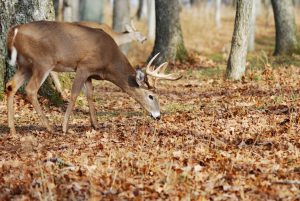
Photo: Kevin Kelly/Kentucky Department Fish and Wildlife
A white-tailed deer from western Kentucky is the state’s first confirmed case of hemorrhagic disease this year.
Murray State University’s Breathitt Veterinary Center recently confirmed to the Kentucky Department of Fish and Wildlife Resources that a deceased female deer recovered from Graves County tested positive for hemorrhagic disease, sometimes referred to as “blue tongue” or EHD. Kentucky Fish and Wildlife is investigating other possible cases involving 22 deer in 11 counties and expects the number could grow in the coming weeks.
“Hemorrhagic disease cannot be transmitted to people or pets,” said Dr. Christine Casey, state wildlife veterinarian for Kentucky Fish and Wildlife. “It is caused by two different viruses: epizootic hemorrhagic disease virus (EHD) and bluetongue virus. These viruses are transmitted to deer by small biting flies, also called no-see-ums.”
Kentucky experiences localized hemorrhagic disease outbreaks each year. More regionally widespread and statewide outbreaks can occur in cycles of five years or longer. A significant regional outbreak of hemorrhagic disease affected many east Kentucky counties two years ago. Far western Kentucky endured an outbreak in 2012, and the last statewide outbreak occurred in 2007.
Outbreaks of hemorrhagic disease generally last from late summer until the first hard frost of the year kills the virus-carrying flies.
Hemorrhagic disease has been present in the United States for more than 60 years. It is not the same as chronic wasting disease (CWD), an always fatal neurological disease that affects white-tailed deer, elk and other members of the deer family. Chronic wasting disease has never been detected in Kentucky.
One main difference between the diseases is that some deer do survive hemorrhagic disease outbreaks and produce protective antibodies, which can be passed to their young. Protective antibodies are major contributors to herd immunity and one reason why Kentucky sees cyclic outbreaks of hemorrhagic disease, rather than a higher prevalence every year.
In Kentucky and across the Midwest, deer that die from hemorrhagic disease typically die within 24 to 36 hours after being bitten by an infected insect. People often find carcasses of deer that have died from the disease around water, and because they died rapidly these animals can appear well fed or otherwise normal. Sometimes there are several carcasses in one area.
While elk in Appalachian Kentucky also contract hemorrhagic disease from insect bites, they usually show no outward signs of illness and death does not occur.
“Kentucky’s archery deer hunting season opens early next month,” said Gabe Jenkins, deer and elk program coordinator with Kentucky Fish and Wildlife. “The department is asking hunters and others to be on the lookout for sick looking deer.
“Deer with hemorrhagic disease can be more susceptible to other diseases. For that reason, the department always cautions against eating the meat from a deer that doesn’t appear to be healthy.”
Through Aug. 21, Kentucky Fish and Wildlife had received reports of suspected hemorrhagic disease in 22 deer. The reports originated from Anderson, Carroll, Christian, Graves, Greenup, Harrison, Meade, Oldham, Trimble, Scott and Shelby counties. The only confirmed case was the Graves County deer. Kentucky Fish and Wildlife is awaiting test results on others.
People can go online now to report to Kentucky Fish and Wildlife suspected cases of hemorrhagic disease in dead or dying deer. The digital form is available at fw.ky.gov under the “Important Info” tab. It takes only a few minutes to complete but provides important data for estimating the scale of the outbreak and for communicating with the public.
Reports also can be submitted by phone. Kentucky Fish and Wildlife staffs a toll-free number weekdays from 8 a.m. to 4:30 p.m. (Eastern). The number is 1-800-858-1549. In addition to their name and contact information, callers will be asked to provide the following about their observation: county and date, number of deer found, and whether the deer were sick or recently deceased.
Information reported to Kentucky Fish and Wildlife through these channels will help the department create maps so the public can see the extent of the disease’s spread.
For more information about hemorrhagic disease, visit the Kentucky Fish and Wildlife website at fw.ky.gov and search for the phrase, “Hemorrhagic Disease.”
 Weather
Weather Traffic
Traffic @LouisvilleDispatch
@LouisvilleDispatch @LouisvilleDisp
@LouisvilleDisp Subscribe
Subscribe
Leave a Reply